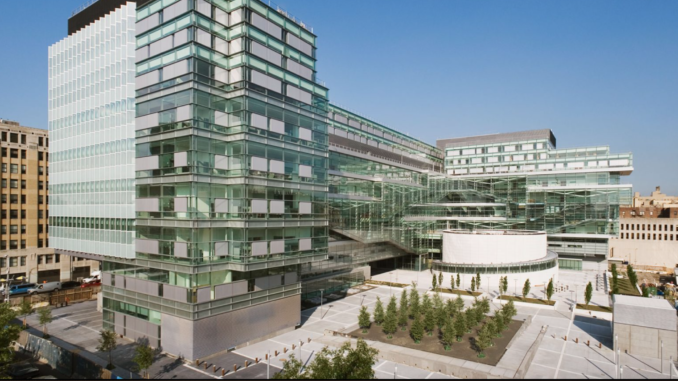
By Kevin Deutsch
[email protected]
In response to a Freedom of Information Law filing by Bronx Justice News, the state Dormitory Authority on Wednesday said it was still searching its records to determine how much taxpayer money it spent to construct the Bronx Hall of Justice—including its shuttered civic plaza.
“DASNY is searching its files for records that would satisfy your request,” Michael Johnson, Assistant General Counsel for the Dormitory Authority, wrote in a FOIL response letter. “We expect to write within twenty (20) business days…At that time, we will report to you on the status of our search and determination of the accessibility of the records gathered.”
A Bronx Justice News investigation last month revealed years of government waste, infrastructure problems, and delays at the Hall of Justice, including problems with its sprawling civic plaza—an open-air space intended as a publicly accessible courtyard—that have kept it from a public opening 11 years after its construction.
While state officials estimated building costs at about $421 million when the courthouse opened, no precise, official figure has been publicly released. The construction manager who completed the building, Hill International, put the project’s value at $450 million. Genesys Engineering, another company involved in building the courthouse, put it at $700 million.
The Hall of Justice is owned and maintained by the city, with the Department of Citywide Administrative Services responsible for day-to-day facilities management. The project’s construction was overseen by the Dormitory Authority. And the city’s Department of Design and Construction is overseeing an ongoing $40 million renovation project to address a host of infrastructure problems at the building.
Among them: issues with the heating, cooling, and ventilation systems, as well as “conditions that are causing interior glass to break, removal and replacement of defective paint, repair of damaged ductwork in the garage area, and rehabbing of the building’s sewer line and plumbing vent line,” a DDC spokesman recently said.
Construction on the courthouse ran three years behind schedule and $100 million over budget. The lowest-bidding contractor was disqualified because of suspected mob ties, and testing revealed soil at at the construction site to be contaminated with oil, spurring cost overruns and delays.
Just a few years after opening, the Hall of Justice was already involved in a host of lawsuit claims involving more than 30 parties, from government agencies and builders to engineers and contractors. The Dormitory Authority paid out millions of dollars in settlement money, and also recouped some in judgements, records show.
The problems with the courthouse didn’t end there: a construction worker pouring concrete at the construction site was killed, the building’s supposedly bomb-proof glass panels were regularly damaged, and a 75-foot canopy at the courthouse’s entrance was removed after inspectors deemed it unstable. The initial inspectors who improperly signed off on the canopy work were not certified, officials said at the time.
The matter was referred to the Bronx District Attorney’s Office and U.S. Attorney’s Office in 2007, but no charges were ever brought.
The late-2000s saw more problems: Roof leaks, flooding, mold, power outages, and broken elevators and escalators.
The project’s construction manager, Bovis Lend Lease, used numerous contractors at the site. The company, one of the world’s largest construction firms, admitted to a massive over billing scheme on New York projects in 2012–including the Hall of Justice. They were hit with $56 million in fines and restitution fees as a result.
Responding to Bronx Justice News’ findings, City Councilman Ritchie Torres’ last week announced a two-pronged plan for getting answers about how, and why, so much has gone wrong at the courthouse.
First, he announced a referral to the Department of Investigation—over which his committee has jurisdiction—a move that automatically triggers a DOI probe under city law.
Second, Torres said, he will write laws into the new city budget making funding for DCAS contingent on its providing a plan and timeline for opening the civic plaza; creating a plan to keep it safe; and releasing data about maintenance and repair costs at the 775,000-square-foot property, one of the largest courthouses in America.
The state Dormitory Authority last week declined to make public the amount of taxpayer funds spent to construct the Hall of Justice, including expenditures on the civic plaza and rooftop rock garden, which also remains closed to visitors.
In response, Bronx Justice News submitted the FOIL request last Wednesday.
Torres said he will hold a budget hearing on city expenditures on the courthouse later this month, and alert DOI Commissioner Margaret Garnett that the investigation is a priority for his committee.
As for state oversight, the office of State Comptroller Thomas P. DiNapoli—New York’s chief fiscal officer and the government official tasked with ensuring state and local governments use taxpayer money effectively and efficiently—has also been monitoring Bronx Justice News’ coverage.
Mark Johnson, Press Officer for the comptroller’s office, said it is the agency’s policy “not to announce audits until they are initiated.”
“We also don’t generally start an audit if there is already another investigation underway,” Johnson said, suggesting the office will wait on the results of the DOI probe.
